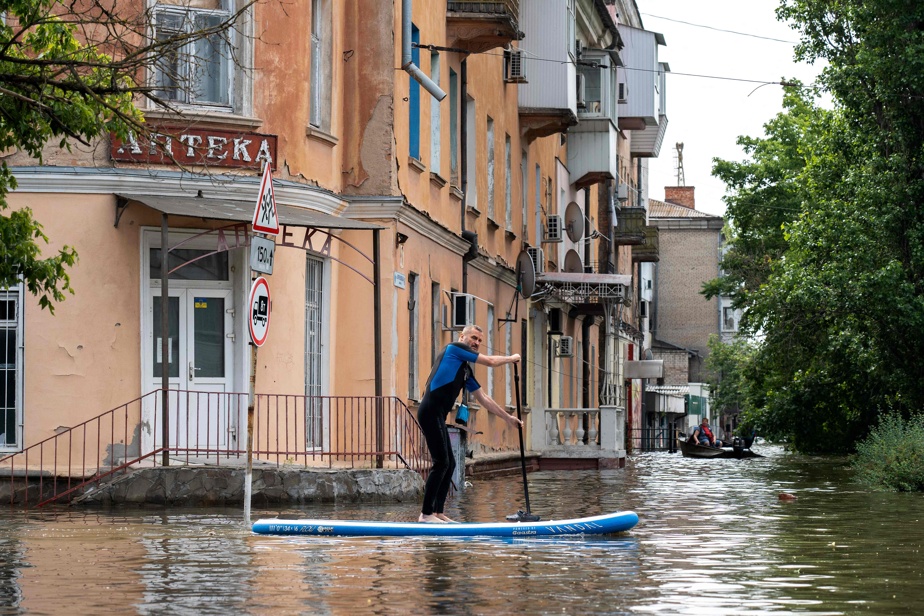When a dam has been mined with Russian explosives for more than a year, when Russia attacks Ukraine, when the Russians have proven themselves capable of the worst war crimes, how does the international community react in the face of a humanitarian and ecological catastrophe? unfolding before our eyes? “We don’t know the culprit,” the media tell us. “We are overwhelmed,” NGOs and international organizations tell us, without taking any action in the name of false neutrality.
On June 6, Russia destroyed the Nova Kakhovka hydroelectric dam, causing ecocide not seen in decades. More than 18km3 of water threaten the lives of the inhabitants of 80 localities on both banks of the Dnipro, thousands of animals have been drowned, and the ecosystem is affected for decades to come. Some 400,000 hectares of Ukrainian agrarian soil will now be without irrigation.
There is no question of waiting for “an international investigation”, of knowing who is wrong or who is right; all signs point to the real culprit. To understand this, you have to put the Kakhovka dam explosion in context. You should already know that the territory of the hydroelectric power station was still occupied by Russian forces. The Kherson region, north of the Dnipro, has gone through Russian occupation, and since its liberation by the Ukrainian army in November 2022, has suffered almost daily artillery attacks.
The southern bank of the Dnipro, where the town of Oleshky is located, is still occupied by the Russians, and the latter refuse any help or evacuations to the populations trapped by the rising waters. They did, however, take the trouble to move their military units in the days before the dam exploded, as satellite images show.
Faced with such a catastrophe, one would have expected a massive response from international and humanitarian organizations, and yet, apart from official declarations, radio silence. During a press conference on June 7, Volodymyr Zelensky indicated that he had appealed to the international community for the affected populations to have help. He picked up the answering machine of the Red Cross and the UN. Ukrainian civil society is inflamed by this lack of reaction: hundreds of Ukrainian volunteers have gone there, and are helping the inhabitants to evacuate, while serving as targets for the Russian army located on the other side of the river.1, while the international community does nothing. Ah yes, the UN has promised to ask Russia’s permission to access the occupied areas and evacuate the civilians, the same ones that Russia wanted to drown… do you see the irony?

PHOTO ALEKSEY FILIPPOV, AGENCE FRANCE-PRESSE
Cat in distress in Kherson, June 8. The author deplores the “neutrality” of the international community and organizations, which serves the invader, according to her.
The brake on any action seems to be, beyond the traditional bureaucracy of such organizations, their desire to remain neutral. However, if the aggressor state relies on this vagueness and this neutrality to advance its propaganda, how can we afford it? If this so-called neutrality serves the invader, how can we remain idly by?
The non-response of international and non-governmental organizations to this disaster is part of a habit, falling within these principles of neutrality which block any action to help the Ukrainians. Amnesty International pulled itself into the limelight for similar reasons last August when it published a report blaming Ukraine’s armed forces for endangering civilians, putting victim and perpetrator on an equal footing. . This demonstrates the total insensitivity of NGOs on this subject, even if Amnesty says it “regrets” its remarks.
The Ukrainians, accustomed to supporting each other, need massive and accelerated support from the international community. It is not by appealing to journalistic or humanitarian impartiality that we will help Ukraine, because it is precisely this neutrality that benefits the Russian aggressor.
Who is silent consents. To be neutral is to be complicit.
1. Nearly a dozen people were injured by Russian artillery strikes on the flooded neighborhoods of Kherson.

